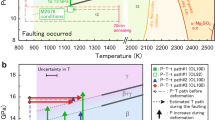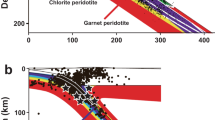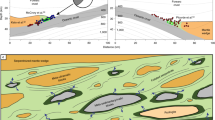Abstract
Intermediate-depth earthquakes in cold subduction zones are observed within the subducting oceanic crust, as well as the mantle1,2. In contrast, intermediate-depth earthquakes in hot subduction zones predominantly occur just below the Mohorovičić discontinuity1. These observations have stimulated interest in relationships between blueschist-facies metamorphism and seismicity, particularly through dehydration reactions involving the mineral lawsonite1,2. Here we conducted deformation experiments on lawsonite, while monitoring acoustic emissions, in a Griggs-type deformation apparatus. The temperature was increased above the thermal stability of lawsonite, while the sample was deforming, to test whether the lawsonite dehydration reaction induces unstable fault slip. In contrast to similar tests on antigorite, unstable fault slip (that is, stick–slip) occurred during dehydration reactions in the lawsonite and acoustic emission signals were continuously observed. Microstructural observations indicate that strain is highly localized along the fault (R1 and B shears), and that the fault surface develops slickensides (very smooth fault surfaces polished by frictional sliding). The unloading slope during the unstable slip follows the stiffness of the apparatus at all experimental conditions, regardless of the strain rate and temperature ramping rate. A thermomechanical scaling factor3 for the experiments is within the range estimated for natural subduction zones, indicating the potential for unstable frictional sliding within natural lawsonite layers.
This is a preview of subscription content, access via your institution
Access options
Subscribe to this journal
Receive 51 print issues and online access
$199.00 per year
only $3.90 per issue
Buy this article
- Purchase on Springer Link
- Instant access to full article PDF
Prices may be subject to local taxes which are calculated during checkout


 .
.

Similar content being viewed by others
References
Kita, S., Okada, T., Nakajima, J., Matsuzawa, T. & Hasegawa, A. Existence of a seismic belt in the upper plane of the double seismic zone extending in the along-arc direction at depths of 70–100 km beneath NE Japan. Geophys. Res. Lett. 33, http://dx.doi.org/10.1029/2006GL028239 (2006)
Abers, G. A., Nakajima, J., van Keken, P. E., Kita, S. & Hacker, B. R. Thermal–petrological controls on the location of earthquakes within subducting plates. Earth Planet. Sci. Lett. 369–370, 178–187 (2013)
Chernak, L. J. & Hirth, G. Syndeformational antigorite dehydration produces stable fault slip. Geology 39, 847–850 (2011)
Hacker, B. R. Subduction factory 2. Are intermediate-depth earthquakes in subducting slabs linked to metamorphic dehydration reactions? J. Geophys. Res. 108, http://dx.doi.org/10.1029/2001JB001129 (2003)
Marschall, H. R., Altherr, R. & Rüpke, L. Squeezing out the slab—modelling the release of Li, Be and B during progressive high-pressure metamorphism. Chem. Geol. 239, 323–335 (2007)
Abers, G. A., van Keken, P. E., Kneller, E. A., Ferris, A. & Stachnik, J. C. The thermal structure of subduction zones constrained by seismic imaging: Implications for slab dehydration and wedge flow. Earth Planet. Sci. Lett. 241, 387–397 (2006)
van Keken, P., Kita, S. & Nakajima, J. Thermal structure and intermediate-depth seismicity in the Tohoku-Hokkaido subduction zones. Solid Earth 3, 355–364 (2012)
Hacker, B. R. H2O subduction beyond arcs. Geochem. Geophys. Geosyst. 9, http://dx.doi.org/10.1029/2007gc001707 (2008)
Raleigh, C. & Paterson, M. Experimental deformation of serpentinite and its tectonic implications. J. Geophys. Res. 70, 3965–3985 (1965)
Gasc, J. et al. Simultaneous acoustic emissions monitoring and synchrotron X-ray diffraction at high pressure and temperature: calibration and application to serpentinite dehydration. Phys. Earth Planet. Inter. 189, 121–133 (2011)
Getsinger, A. J. & Hirth, G. Amphibole fabric formation during diffusion creep and the rheology of shear zones. Geology 42, 535–538 (2014)
Paterson, M. S. & Olgaard, D. L. Rock deformation tests to large shear strains in torsion. J. Struct. Geol. 22, 1341–1358 (2000)
Newton, R. C. & Kennedy, G. Some equilibrium reactions in the join CaAl2Si2O8-H2O. J. Geophys. Res. 68, 2967–2983 (1963)
Ulmer, P. & Trommsdorff, V. Serpentine stability to mantle depths and subduction-related magmatism. Science 268, 858–861 (1995)
Frost, H. J. & Ashby, M. F. Deformation-Mechanism Maps: the Plasticity and Creep of Metals and Ceramics 49–51 (Pergamon, 1982)
Schmidt, M. W. & Poli, S. The stability of lawsonite and zoisite at high pressures: experiments in CASH to 92 kbar and implications for the presence of hydrous phases in subducted lithosphere. Earth Planet. Sci. Lett. 124, 105–118 (1994)
Jung, H., Fei, Y., Silver, P. G. & Green, H. W. Frictional sliding in serpentine at very high pressure. Earth Planet. Sci. Lett. 277, 273–279 (2009)
Paterson, M. S. & Wong, T.-f. Experimental Rock Deformation—The Brittle Field (Springer, 2005)
Hadizadeh, J. & Tullis, J. Cataclastic flow and semi-brittle deformation of anorthosite. J. Struct. Geol. 14, 57–63 (1992)
Schubnel, A. et al. Deep-focus earthquake analogs recorded at high pressure and temperature in the laboratory. Science 341, 1377–1380 (2013)
Hilairet, N. et al. High-pressure creep of serpentine, interseismic deformation, and initiation of subduction. Science 318, 1910–1913 (2007)
Scholz, C. H. The Mechanics of Earthquakes and Faulting 81–90 (Cambridge Univ. Press, 2002)
Wada, I. & Wang, K. Common depth of slab-mantle decoupling: reconciling diversity and uniformity of subduction zones. Geochem. Geophys. Geosyst. 10, http://dx.doi.org/10.1029/2009gc002570 (2009)
Proctor, B. & Hirth, G. Role of pore fluid pressure on transient strength changes and fabric development during serpentine dehydration at mantle conditions: implications for subduction-zone seismicity. Earth Planet. Sci. Lett. 421, 1–12 (2015)
Hirose, F., Nakajima, J. & Hasegawa, A. Three-dimensional seismic velocity structure and configuration of the Philippine Sea slab in southwestern Japan estimated by double-difference tomography. J. Geophys. Res. 113, http://dx.doi.org/10.1029/2007JB005274 (2008)
Kelemen, P. B. & Hirth, G. A periodic shear-heating mechanism for intermediate-depth earthquakes in the mantle. Nature 446, 787–790 (2007)
Katayama, I., Terada, T., Okazaki, K. & Tanikawa, W. Episodic tremor and slow slip potentially linked to permeability contrasts at the Moho. Nature Geosci. 5, 731–734 (2012)
Tsuji, Y., Nakajima, J. & Hasegawa, A. Tomographic evidence for hydrated oceanic crust of the Pacific slab beneath northeastern Japan: implications for water transportation in subduction zones. Geophys. Res. Lett. 35, http://dx.doi.org/10.1029/2008GL034461 (2008)
Kim, D., Katayama, I., Michibayashi, K. & Tsujimori, T. Rheological contrast between glaucophane and lawsonite in naturally deformed blueschist from Diablo Range, California. Island Arc 22, 63–73 (2013)
Forneris, J. F. & Holloway, J. R. Phase equilibria in subducting basaltic crust: implications for H2O release from the slab. Earth Planet. Sci. Lett. 214, 187–201 (2003)
Sawai, M., Katayama, I., Hamada, A., Maeda, M. & Nakashima, S. Dehydration kinetics of antigorite using in situ high-temperature infrared microspectroscopy. Phys. Chem. Miner. 40, 319–330 (2013)
Okazaki, K. & Katayama, I. Slow stick slip of antigorite serpentinite under hydrothermal conditions as a possible mechanism for slow earthquakes. Geophys. Res. Lett. 42, 1099–1104 (2015)
Chernak, L. J. & Hirth, G. Deformation of antigorite serpentinite at high temperature and pressure. Earth Planet. Sci. Lett. 296, 23–33 (2010)
Perrillat, J. et al. Kinetics of antigorite dehydration: a real-time X-ray diffraction study. Earth Planet. Sci. Lett. 236, 899–913 (2005)
Acknowledgements
We thank A. Schubnel, D. Forsyth, T. Altman and T. Togo for technical advice on the acoustic emissions measurement, B. Proctor for discussion and assistance in the laboratory, J. Boesenberg for technical assistance with the electron probe microanalyser, R. Milliken and K. Robertson for helping with XRD measurements, and H. Marschall and Terry E. Tullis for discussions. This study was supported by the US National Science Foundation (EAR-1049582, EAR-1315784).
Author information
Authors and Affiliations
Contributions
G.H. proposed the project. K.O. conducted experiments and microstructural and mechanical analyses. K.O. took all the photographs. Both authors contributed to developing the main ideas, designing the experiments, interpreting the results and writing the manuscript.
Corresponding author
Ethics declarations
Competing interests
The authors declare no competing financial interests.
Extended data figures and tables
Extended Data Figure 1 Lawsonite vein sample and XRD spectra for samples.
a, The lawsonite vein in a lawsonite–blueschist block from the Franciscan Complex in California, USA, used for the starting material for the temperature ramp experiments. b and c, XRD spectra for the starting material (SM) and recovered samples (W1946 and W1965) from experiments on simulated lawsonite gouge. Most of the peaks in the SM are lawsonite (lw); there are minor peaks of staurolite (st) and glaucophane (gl). Spectra for the recovered samples from a temperature ramping experiment (W1965) show a weaker peak in lawsonite than in the SM and small peaks for anorthite (an). Anorthite, which is formed by lawsonite break down (Fig. 1 and Extended Data Fig. 3), is evidence of lawsonite dehydration. Corundum peaks (cr) are contamination from the alumina shear piston. We did not find any reaction products in the recovered sample deformed within the lawsonite stability field with no temperature ramping (W1946). d, f, Cross-polarized light micrographs of a hot-pressed sample (W1943) and a sample from a temperature ramping experiment (W1971), respectively. e, g, Same regions as d and f, but with the gypsum plate inserted under cross-polarized light. cps, counts per second.
Extended Data Figure 2 Stick–slip behaviour of lawsonite gouge without temperature ramping.
a, A violent stick–slip of lawsonite was observed in an experiment (W1946) conducted with no temperature ramping at 400 °C, at a confining pressure of 1.0 GPa, and an axial displacement rate of 0.18 μm s−1 (Extended Data Table 1). Because of the enormously large stress drop and fast slip, the thermocouple failed, and the load point displacement was not measured correctly during the stick–slip event, so the unloading slope for this run could not be estimated. b, Enlargement of the stick–slip event.
Extended Data Figure 3 Sample assembly used in this study (a) and pressure–temperature paths for the temperature ramping experiments (b).
Pink circle and black triangle show pressure–temperature paths for lawsonite and for antigorite, respectively. Blue lines show the lawsonite phase diagram for the CaO–SiO2–H2O system13 applicable for the experimental system in this study. Grey lines show the lawsonite stability limit in the MORB system30 applicable for the natural subduction zone setting. Green lines show the phase diagram for antigorite in the MgO–SiO2–H2O system14,34. Atg = antigorite, Zo = zoisite, Ky = kyanite, Qz = quartz, An = anorthite, Fo = forsterite, Tlc = talc, En = enstatite, Tlc-like = talc-like phase.
Rights and permissions
About this article
Cite this article
Okazaki, K., Hirth, G. Dehydration of lawsonite could directly trigger earthquakes in subducting oceanic crust. Nature 530, 81–84 (2016). https://doi.org/10.1038/nature16501
Received:
Accepted:
Published:
Issue Date:
DOI: https://doi.org/10.1038/nature16501
This article is cited by
-
Impact of chlorite dehydration on intermediate-depth earthquakes in subducting slabs
Communications Earth & Environment (2023)
-
Nanometric flow and earthquake instability
Nature Communications (2021)
-
Dehydration-induced earthquakes identified in a subducted oceanic slab beneath Vrancea, Romania
Scientific Reports (2021)
-
The stability of subducted glaucophane with the Earth’s secular cooling
Nature Communications (2021)
-
Ammonium Impacts on Vibrations of Hydroxyl and Lattice of Phengite at High Temperature and High Pressure
Journal of Earth Science (2021)
Comments
By submitting a comment you agree to abide by our Terms and Community Guidelines. If you find something abusive or that does not comply with our terms or guidelines please flag it as inappropriate.



